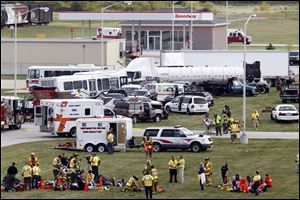
Firefighters, medical technicians simulate 50-vehicle pileup
9/25/2013
Authorities respond to cars in a simulation that included a 40-50 car pile-up caused by a tornado on the Ohio Turnpike between I-280 and I-75 during a Lucas & Northern Wood County Mass Casualty Incident Response Plan exercise at Owens Community College.
Firefighters and medical technicians from more than a dozen area fire departments participated in a mass-casualty exercise today simulating a 50-vehicle pileup on the Ohio Turnpike.
Scores of students from several area high schools played the roles of victims while responders searched the tangle of vehicles -- mostly cars, but a few tractor-trailers, at least one van, and a Toledo Area Regional Transit Authority bus -- to determine who needed help most urgently and to usher those least "injured" to safety.
Paid for with a $55,600 federal Department of Homeland Security grant, the drill conducted at the Owens Community College Center for Emergency Preparedness in Perrysburg Township was intended to see how well participants could communicate and coordinate their efforts after receiving several months of training specific to mass-casualty incidents.
"Our purpose is that we have a plan to respond" to such an event, Toledo Fire Lt. Cheryl Hill, the exercise's director, said afterward. "We need to be able to activate the plan and get resources on the road right away."
Agencies from throughout Lucas and northern Wood counties, along with the Bedford Fire Department from Michigan and Allen-Clay in Ottawa County, participated. Patients were "sent" to six hospitals in Lucas County, with a separate group of students playing those roles.
According to the scenario, the chain-reaction crash was caused by a tornado, but such a pile-up could easily result from other causes, such as fog or a snow squall.